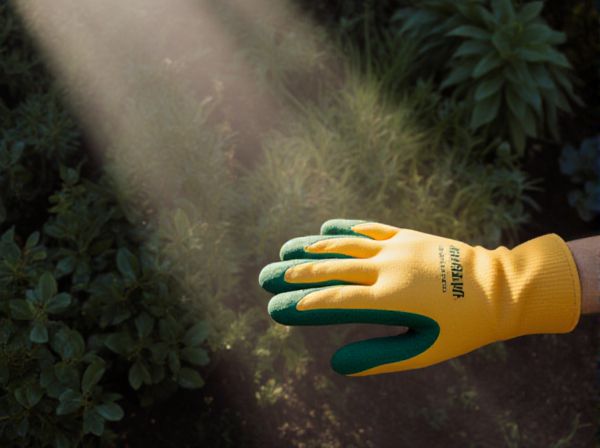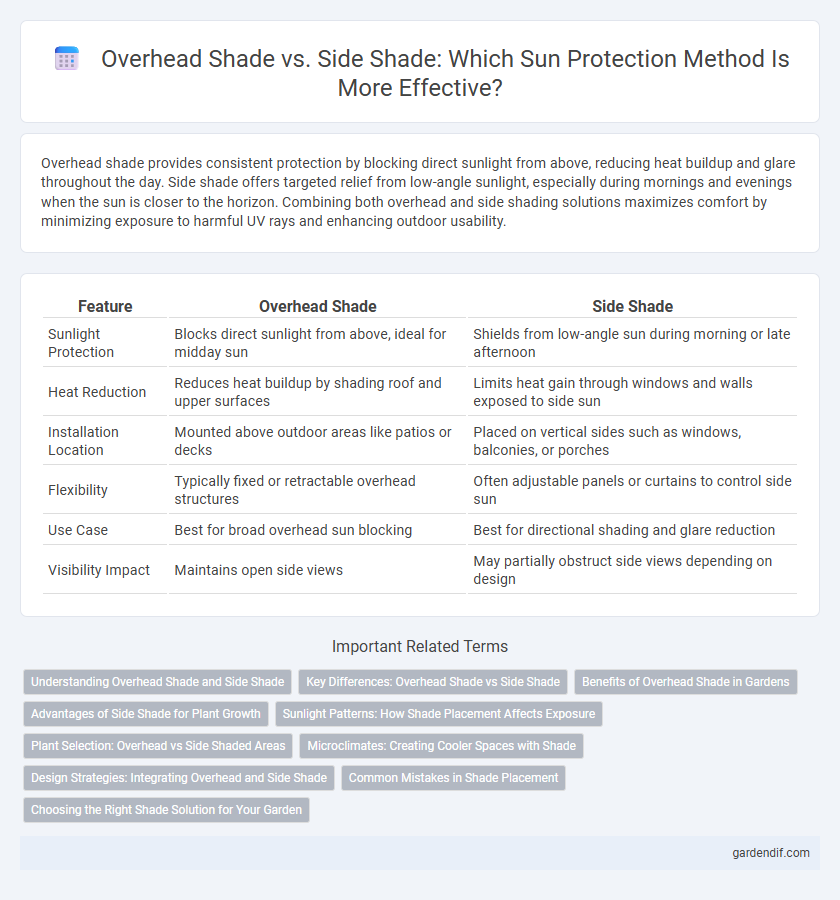
Overhead Shade vs Side Shade Illustration
Overhead shade provides consistent protection by blocking direct sunlight from above, reducing heat buildup and glare throughout the day. Side shade offers targeted relief from low-angle sunlight, especially during mornings and evenings when the sun is closer to the horizon. Combining both overhead and side shading solutions maximizes comfort by minimizing exposure to harmful UV rays and enhancing outdoor usability.
Table of Comparison
| Feature | Overhead Shade | Side Shade |
|---|---|---|
| Sunlight Protection | Blocks direct sunlight from above, ideal for midday sun | Shields from low-angle sun during morning or late afternoon |
| Heat Reduction | Reduces heat buildup by shading roof and upper surfaces | Limits heat gain through windows and walls exposed to side sun |
| Installation Location | Mounted above outdoor areas like patios or decks | Placed on vertical sides such as windows, balconies, or porches |
| Flexibility | Typically fixed or retractable overhead structures | Often adjustable panels or curtains to control side sun |
| Use Case | Best for broad overhead sun blocking | Best for directional shading and glare reduction |
| Visibility Impact | Maintains open side views | May partially obstruct side views depending on design |
Understanding Overhead Shade and Side Shade
Overhead shade primarily reduces direct solar radiation by blocking sunlight from above, minimizing heat gain and glare on horizontal surfaces. Side shade, on the other hand, intercepts low-angle sunlight during mornings and evenings, protecting vertical surfaces and interior spaces from excessive light and heat. Both shading strategies optimize daylight control and energy efficiency by targeting different angles of sun exposure.
Key Differences: Overhead Shade vs Side Shade
Overhead shade primarily blocks sunlight from directly above, reducing UV exposure and heat on surfaces beneath, making it ideal for controlling midday sun. Side shade obstructs low-angle sunlight from the east or west, providing protection during morning or evening hours and significantly reducing glare. Both shading types optimize energy efficiency and comfort depending on the sun's position and seasonal variations.
Benefits of Overhead Shade in Gardens
Overhead shade in gardens provides uniform protection from intense sunlight, reducing heat stress on plants and promoting consistent growth by minimizing leaf scorch. It enhances water retention in soil by limiting evaporation, which supports healthier root systems and decreases irrigation needs. This shade type also creates a cooler microclimate for gardeners and beneficial insects, fostering a balanced ecosystem conducive to plant health.
Advantages of Side Shade for Plant Growth
Side shade provides optimal light diffusion, reducing direct sunlight intensity while allowing sufficient ambient light for photosynthesis, which enhances plant growth. This shading method improves air circulation around plants, minimizing heat stress and preventing fungal diseases. By mimicking natural shaded environments, side shade supports healthier leaf development and promotes robust root systems.
Sunlight Patterns: How Shade Placement Affects Exposure
Overhead shade reduces direct sunlight by blocking rays during midday when the sun is highest, creating consistent cooling beneath its coverage. Side shade primarily affects sunlight exposure during morning and late afternoon, limiting glare and reducing heat from angled sun rays. Understanding these sunlight patterns helps optimize shade placement for effective temperature control and comfort throughout the day.
Plant Selection: Overhead vs Side Shaded Areas
Overhead shade is ideal for plants like ferns and hostas that thrive in diffused, dappled sunlight, while side shade suits climbing plants such as ivy and clematis that benefit from partial sun and sheltered conditions. Selecting plants adapted to these specific light patterns maximizes photosynthesis efficiency and growth performance. Understanding the nuanced light intensity and duration in overhead versus side shaded areas guides optimal plant placement in garden design.
Microclimates: Creating Cooler Spaces with Shade
Overhead shade reduces direct solar radiation by blocking sunlight from above, significantly lowering temperatures in outdoor areas and creating cooler microclimates beneath trees, pergolas, or shade sails. Side shade, such as walls, fences, or tall plants, intercepts low-angle sunlight during mornings and evenings, enhancing comfort by minimizing lateral sun exposure and reducing glare. Combining both overhead and side shade maximizes cooling effects, optimizing microclimates for prolonged outdoor use and energy-efficient environments.
Design Strategies: Integrating Overhead and Side Shade
Integrating overhead and side shade enhances sunlight control by combining vertical and horizontal shading elements to reduce glare and heat gain. Effective design strategies include adjustable louvers and pergolas for overhead protection, paired with operable side screens or vegetation to block low-angle sun exposure. This hybrid approach maximizes daylight while improving thermal comfort and energy efficiency in buildings.
Common Mistakes in Shade Placement
Placing overhead shade too close to building facades can block desirable winter sunlight, reducing natural heating and daylighting. Side shades often mistakenly extend too far, causing excessive shadow and limiting solar access during critical daylight hours. Proper evaluation of sun angles throughout the year is essential to avoid these common shade placement errors.
Choosing the Right Shade Solution for Your Garden
Overhead shade provides consistent protection by blocking direct sunlight from above, ideal for full-sun gardens needing relief during peak hours. Side shade offers targeted coverage, shielding plants from low-angle sunlight and harsh afternoon rays, perfect for gardens with exposure to eastern or western light. Choosing the right shade solution depends on garden orientation, plant species' light requirements, and the daily sun path to optimize growth and comfort.
Overhead Shade vs Side Shade Infographic

 gardendif.com
gardendif.com